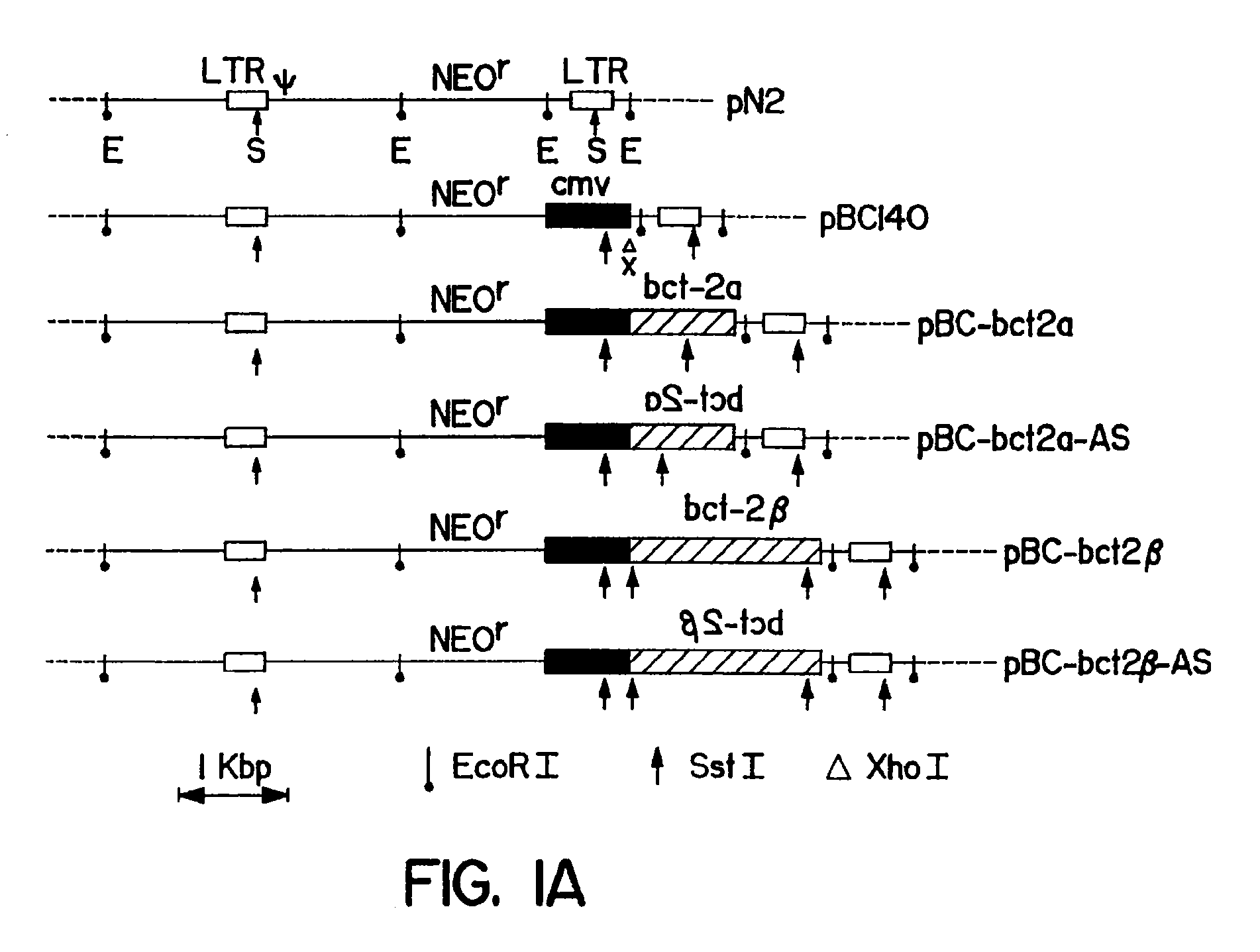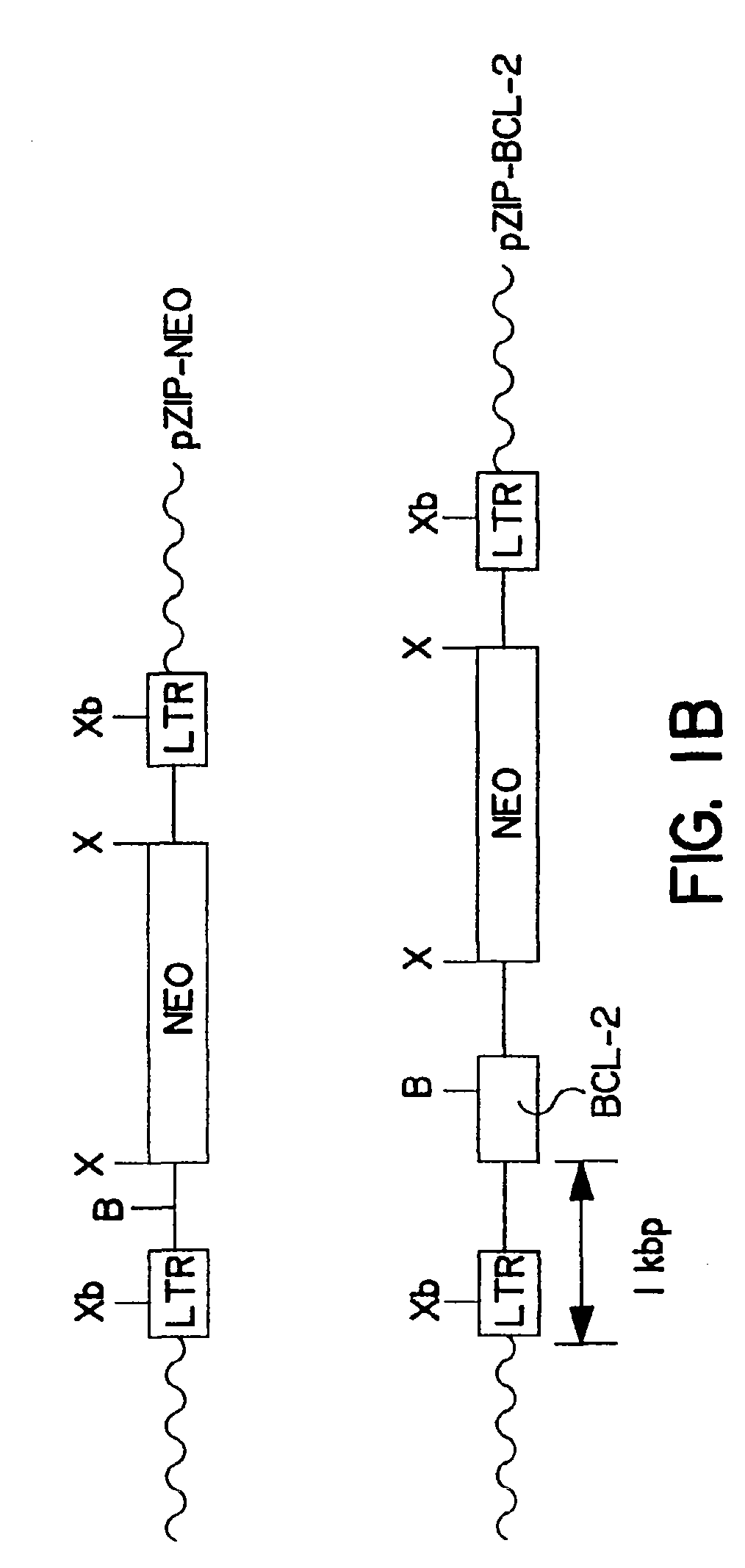Methods of using BCL-2 for the therapeutic treatment and prevention of diseases
a technology of bcl-2 and disease, applied in the field of apoptosis, can solve the problems of failure of many cells that initially survive to continue long-term in vivo survival, yield only minor progress toward effective treatment, etc., and achieve the effect of prolonging the in vivo survival of transplanted cells, and increasing the activity of bcl-2
- Summary
- Abstract
- Description
- Claims
- Application Information
AI Technical Summary
Benefits of technology
Problems solved by technology
Method used
Image
Examples
example i
This Example shows that Bcl-2 expression results in an increased number of viable 32D-3 cells in culture and allows the cells to remain viable for longer than normally observed for this cell line.
32D-3 cells were stably transfected with expression plasmids containing a G418 antibiotic resistance gene and either a wild-type or mutant human Bcl-2 DNA sequence. The mutant Bcl-2 sequence encodes a variant Bcl-2 protein having a serine substitution for a proline at amino acid position 59 (BCL2 / P59S). This amino acid substitution results in a high level of constitutive expression of BCL2 / P59S.
Following selection of the cells for G418 resistance, cells were plated and their viability was determined. As shown in FIG. 2.A., the number of viable control cells (Neo) reached a maximum about day 4-5, then decreased. The number of viable cells expressing the wild-type Bcl-2 protein (W.T.) also reached a maximum at about day 4-5, but the number of viable cells did not decrease during the time exam...
example ii
This Example illustrates the effectiveness of Bcl-2 at preventing Sindbis virus-induced death of prostate cancer cells.
A rat prostate cancer cell line, AT-3, was infected with pZIP-BCL2 or pZIP-NEO (see FIG. 1.B.), then grown in the presence or absence of Sindbis virus. At various times after the addition of Sindbis virus, cells were collected and cell viability was determine using trypan blue exclusion.
As shown in FIG. 3, Sindbis virus infection resulted in the death of essentially all of the AT-3 cells within 3 days (solid circles). In contrast, AT-3 cells that expressed Bcl-2 were protected from Sindbis virus-induced death (solid squares) and survived as if no Sindbis virus was present (compare controls, open circles). These results show that Bcl-2 expression protects cells from death due to virus infection.
example iii
This Example demonstrates the effectiveness of Bcl-2 for inhibition of glutamate-induced apoptosis in cultured neuronal PC12 cells.
Glutamate is released from dying neurons in the brain during stroke and other conditions where neuronal cell survival is compromised including, perhaps, ALS. Neurons contain cell surface glutamate receptors that appear to transduce poorly characterized signals leading to apoptotic cell death. In vitro studies have shown that glutamate treatment can result in the death of cultured cortical neurons and PC12 cells. Glutamate-induced cell death induced is accompanied by internucleosomal DNA degradation and ultrastructural changes resulting from apoptosis. Bcl-2 expression protects neuronal cells from glutamate-induced cell death.
The rat pheochromocytoma cell line, PC12, was stably infected with pZIP-BCL-2 or pZIP-NEO (see FIG. 1.A.), then treated with 30 mM glutamate for 24 hours. Following treatment, cell viability was assessed by MTT dye reduction assay as...
PUM
 Login to View More
Login to View More Abstract
Description
Claims
Application Information
 Login to View More
Login to View More - R&D
- Intellectual Property
- Life Sciences
- Materials
- Tech Scout
- Unparalleled Data Quality
- Higher Quality Content
- 60% Fewer Hallucinations
Browse by: Latest US Patents, China's latest patents, Technical Efficacy Thesaurus, Application Domain, Technology Topic, Popular Technical Reports.
© 2025 PatSnap. All rights reserved.Legal|Privacy policy|Modern Slavery Act Transparency Statement|Sitemap|About US| Contact US: help@patsnap.com



